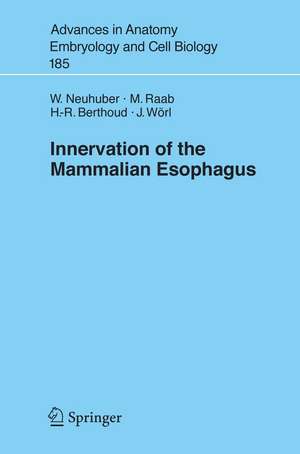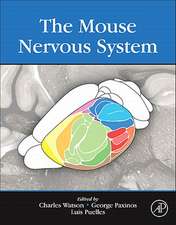Innervation of the Mammalian Esophagus: Advances in Anatomy, Embryology and Cell Biology, cartea 185
Autor Winfried Neuhuber, M. Raab, Hans-Rudolf Berthoud, Jürgen Wörlen Limba Engleză Paperback – 13 feb 2006
Din seria Advances in Anatomy, Embryology and Cell Biology
- 5%
 Preț: 1146.33 lei
Preț: 1146.33 lei - 5%
 Preț: 721.19 lei
Preț: 721.19 lei - 15%
 Preț: 637.13 lei
Preț: 637.13 lei -
 Preț: 381.81 lei
Preț: 381.81 lei - 15%
 Preț: 644.95 lei
Preț: 644.95 lei - 5%
 Preț: 1025.16 lei
Preț: 1025.16 lei - 15%
 Preț: 689.97 lei
Preț: 689.97 lei - 15%
 Preț: 577.07 lei
Preț: 577.07 lei - 15%
 Preț: 580.36 lei
Preț: 580.36 lei - 5%
 Preț: 393.51 lei
Preț: 393.51 lei -
 Preț: 408.66 lei
Preț: 408.66 lei -
![Die Schlüpfdrüse der Geburtshelferkröte (Alytes o. obstetricans [LAURENTI]) und anderer Froschlurche](https://i4.books-express.ro/bs/9783662239742/die-schluepfdruese-der-geburtshelferkroete-alytes-o-obstetricans-laurenti-und-anderer-froschlurche.jpg) Preț: 408.27 lei
Preț: 408.27 lei - 5%
 Preț: 1090.61 lei
Preț: 1090.61 lei - 5%
 Preț: 705.11 lei
Preț: 705.11 lei - 5%
 Preț: 706.04 lei
Preț: 706.04 lei - 5%
 Preț: 357.61 lei
Preț: 357.61 lei - 5%
 Preț: 704.59 lei
Preț: 704.59 lei - 5%
 Preț: 705.11 lei
Preț: 705.11 lei - 5%
 Preț: 359.42 lei
Preț: 359.42 lei - 5%
 Preț: 711.52 lei
Preț: 711.52 lei - 15%
 Preț: 635.47 lei
Preț: 635.47 lei - 15%
 Preț: 631.72 lei
Preț: 631.72 lei - 15%
 Preț: 633.35 lei
Preț: 633.35 lei - 15%
 Preț: 632.37 lei
Preț: 632.37 lei - 5%
 Preț: 706.60 lei
Preț: 706.60 lei - 15%
 Preț: 631.07 lei
Preț: 631.07 lei - 5%
 Preț: 707.13 lei
Preț: 707.13 lei - 5%
 Preț: 707.33 lei
Preț: 707.33 lei - 5%
 Preț: 359.60 lei
Preț: 359.60 lei - 5%
 Preț: 707.69 lei
Preț: 707.69 lei - 5%
 Preț: 707.13 lei
Preț: 707.13 lei - 5%
 Preț: 708.06 lei
Preț: 708.06 lei - 5%
 Preț: 706.41 lei
Preț: 706.41 lei - 5%
 Preț: 708.78 lei
Preț: 708.78 lei - 5%
 Preț: 705.68 lei
Preț: 705.68 lei - 5%
 Preț: 705.11 lei
Preț: 705.11 lei - 5%
 Preț: 706.77 lei
Preț: 706.77 lei - 15%
 Preț: 635.15 lei
Preț: 635.15 lei - 15%
 Preț: 631.07 lei
Preț: 631.07 lei - 5%
 Preț: 706.77 lei
Preț: 706.77 lei - 5%
 Preț: 706.04 lei
Preț: 706.04 lei - 5%
 Preț: 710.79 lei
Preț: 710.79 lei - 5%
 Preț: 705.32 lei
Preț: 705.32 lei - 15%
 Preț: 633.19 lei
Preț: 633.19 lei - 15%
 Preț: 629.09 lei
Preț: 629.09 lei - 15%
 Preț: 633.53 lei
Preț: 633.53 lei - 15%
 Preț: 632.70 lei
Preț: 632.70 lei - 15%
 Preț: 633.68 lei
Preț: 633.68 lei - 18%
 Preț: 773.72 lei
Preț: 773.72 lei - 15%
 Preț: 630.43 lei
Preț: 630.43 lei
Preț: 704.39 lei
Preț vechi: 741.47 lei
-5% Nou
Puncte Express: 1057
Preț estimativ în valută:
134.79€ • 144.13$ • 112.38£
134.79€ • 144.13$ • 112.38£
Carte tipărită la comandă
Livrare economică 18 aprilie-02 mai
Preluare comenzi: 021 569.72.76
Specificații
ISBN-13: 9783540292050
ISBN-10: 3540292055
Pagini: 88
Ilustrații: X, 76 p. 14 illus., 2 illus. in color.
Dimensiuni: 155 x 235 x 5 mm
Greutate: 0.14 kg
Ediția:2006
Editura: Springer Berlin, Heidelberg
Colecția Springer
Seria Advances in Anatomy, Embryology and Cell Biology
Locul publicării:Berlin, Heidelberg, Germany
ISBN-10: 3540292055
Pagini: 88
Ilustrații: X, 76 p. 14 illus., 2 illus. in color.
Dimensiuni: 155 x 235 x 5 mm
Greutate: 0.14 kg
Ediția:2006
Editura: Springer Berlin, Heidelberg
Colecția Springer
Seria Advances in Anatomy, Embryology and Cell Biology
Locul publicării:Berlin, Heidelberg, Germany
Public țintă
ResearchCuprins
Introduction.- Muscle layers of the esophagus.- Materials and Methods. Anterograde WGA-HRP tracing from nodose ganglion. Anterograde DiI tracing from thoracic dorsal root ganglia.- Extrinsic innervation. Vagal innervation.- Spinal innervation. Innervation of esophageal sphincters. Swallowing central pattern generator. Cortical representation of the esophagus in human.- Intrinsic innervation. General organization. Enteric coinnervation.- Functional considerations. General remarks. Cooperation between extrinsic and intrinsic systems.- Concluding remarks.- Summary.- References.- Subject Index.
Textul de pe ultima copertă
Understanding the innervation of the esophagus is a prerequisite for successful treatment of a variety of disorders, e.g., dysphagia, achalasia, gastroesophageal reflux disease (GERD) and non-cardiac chest pain. Although, at first glance, functions of the esophagus are relatively simple, their neuronal control is considerably complex. Vagal motor neurons of the nucleus ambiguus and preganglionic neurons of the dorsal motor nucleus innervate striated and smooth muscle, respectively. Myenteric neurons represent the interface between the dorsal motor nucleus and smooth muscle but are also involved in striated muscle innervation. Intraganglionic laminar endings (IGLEs) represent mechanosensory vagal afferent terminals. They also establish intricate connections with enteric neurons. Afferent information is implemented by the swallowing central pattern generator in the brainstem, which generates and coordinates deglutitive activity in both striated and smooth esophageal muscle and orchestrates esophageal sphincters as well as gastric adaptive relaxation. Disturbed excitation/inhibition balance in the lower esophageal sphincter results in motility disorders, e.g., achalasia and gastroesophageal reflux disease. Loss of mechanosensory afferents disrupts adaptation of deglutitive motor programs to bolus variables, eventually leading to megaesophagus. Both spinal and vagal afferents appear to contribute to painful sensations, e.g., non-cardiac chest pain. Extrinsic and intrinsic neurons may be involved in intramural reflexes using acetylcholine, nitric oxide, substance P, CGRP and glutamate as main transmitters. In addition, other molecules, e.g., ATP, GABA and probably also inflammatory cytokines may modulate these neuronal functions.
Caracteristici
Includes supplementary material: sn.pub/extras









